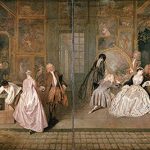 The Image of the Art Market (Berlin, 12-13 Sep 22)
The Image of the Art Market (Berlin, 12-13 Sep 22)
Berlin – TU / Liebermann Villa, Sep 12–13, 2022
Deadline: Apr 21, 2022
The art trade has always been viewed with great fascination, but also with skepticism and even suspicion. Although its worldwide turnover is relatively modest in comparison with most other markets for luxury goods, the art market’s mechanisms, its peak prices and its scandals, attract a seemingly disproportionate amount of public attention. This attention comes not only from the press and (social) media, but also from film and fiction, where extravagant art trade settings speak of passion and money while dealers are variously cast as educated, smart, eccentric or untrustworthy.
The art trade’s flirtations with the limelight and dealers’ careful self-fashioning of their image have a long history. For time immemorial, collecting art has been an essential part of public and private representation and the trade’s role in this system becomes increasingly evident today. Again and again, art market players have operated with glamorous gatherings and media-rich appearances at fairs, auctions and special events. Art dealers have also promoted their business by polishing their expertise, networks and appearance, thus underscoring the social functions of art. Generations of dealers, even across dynasties, have maintained their position in the international marketplace by socializing with celebrities, politicians, museum professionals and scholars. Indeed some of them, such as Pierre Jean Mariette, John Smith, or Frits Lugt, were distinguished scholars themselves.
These activities, documented in countless images and texts, were and are observed with fascination but have also met with criticism. Thus, scientific expertise, connoisseurship and institutional clout sometimes appear as odd bedfellows of commercial acumen. Similarly, calls for transparency regularly clash with the players’ wish for discretion, while due diligence – also with regard to the origin of objects – sometimes assume a secondary role when overshadowed by deft marketing strategies or even manipulative operations. Indeed, the often contradictory magnetic fields at work in this market may be fundamental to its high flying public profile.
This conference thus aims to shed light on the hitherto rarely studied image of the art market, its players and their self-fashioning. Given the richness and complexity of the topic, the TIAMSA Conference 2022, organized in cooperation with Technische Universität Berlin and the Liebermann Villa Berlin, proposes to take a holistic perspective and invites contributions that approach the historical or contemporary image of the art market from all directions. Hence, the following list of topics is only meant as a guide and should not deter colleagues who would like to explore other related subjects:
– the art market and its players in the press
– the portrait of the art dealer
– memoirs of art dealers, their style and aims
– the art market in film and literature
– the staging of events and auctions as public spectacles
– the market’s advertising styles
– the glamour of provenances
– the dealer as expert and scholar
How to apply:
Please submit an abstract (max. one page) and a short biography (max. one page) in PDF-format by 21 April to sharon.dowley@artmarketstudies.org and inna.schill@artmarketstudies.org (please re-contact us you if do not receive an acknowledgment of your submission within 72 hours). Speakers will be notified by 15 May 2022. The call is open to all (members and non-members).
Conference dates/places:
Monday 12 – Tuesday 13 September 2022
Berlin, Technische Universität / Liebermann Villa am Wannsee.
TIAMSA will probably hold its AGM before or after the conference.
Conference language:
The main conference language is English but the committee will consider contributions in other languages if they are of particular relevance to the conference theme.
TIAMSA travel grants:
If your participation depends on a travel grant, please state so clearly together with your submission. In this case, and if your proposal is accepted, the conference committee will award a flat fee (150 Euros for travel from Europe / 400 Euros for travel from overseas). Please apply for this only if you have no alternative sources of funding.
Conference Coordinators:
Sharon Dowley (Independent)
Inna Schill (Independent)
Conference Committee:
Susanna Avery-Quash (National Gallery London)
Meike Hopp (TU Berlin)
Veronika Korbei (Independent Vienna)
Johannes Nathan (Nathan Fine Art / TU Berlin)
Olav Velthuis (University of Amsterdam)
Lucy Wasensteiner (Liebermann Villa Berlin)
For Information on TIAMSA and Its Conference Partners, see:
artmarketstudies.org / kuk.tu-berlin.de / liebermann-villa.de

Leave a Reply
You must be logged in to post a comment.